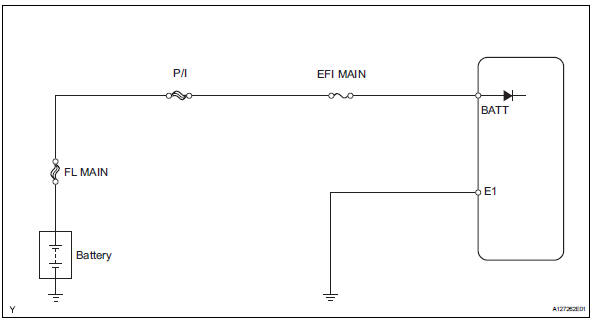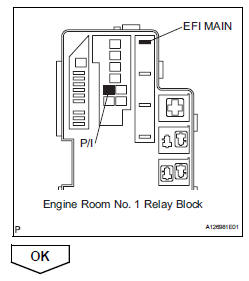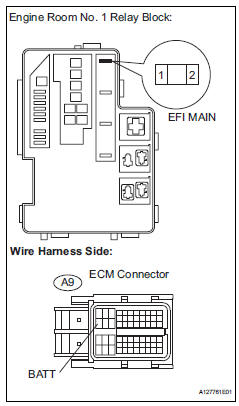Toyota RAV4 (XA40) 2013-2018 Service Manual: System voltage
![]()
Description
The battery supplies electricity to the ecm even when the ignition switch is in the off position. This power allows the ecm to store data such as dtc history, freeze frame data and fuel trim values. If the battery voltage falls below a minimum level, the memory is cleared and the ecm determines that there is a malfunction in the power supply circuit. When the engine is next started, the ecm illuminates the mil and sets the dtc.

Hint:
If dtc p0560 is set, the ecm does not store other dtcs or the data stored in the ecm are partly erased.
Monitor strategy

Typical enabling conditions
![]()
Typical malfunction thresholds
![]()
Wiring diagram

Inspection procedure
Hint:
Read freeze frame data using the intelligent tester. Freeze frame data records the engine condition when malfunctions are detected. When troubleshooting, freeze frame data can help determine if the vehicle was moving or stationary, if the engine was warmed up or not, if the air-fuel ratio was lean or rich, and other data from the time the malfunction occurred.
- Check fuse (efi main and p/i)
- Remove the efi main fuse and p/i fuse from the engine room no. 1 Relay block.
- Measure the resistance of the efi main fuse and p/i fuse.
Standard resistance:
below 1 
- Reinstall the efi main fuse and p/i fuse.


- Check harness and connector (ecm - efi main fuse, efi main fuse - battery)
- Check the harness and the connector between the efi main fuse and ecm.
- Remove the efi main fuse from the engine no. 1 Room relay block.
- Disconnect the a9 ecm connector.
- Measure the resistance.
Standard resistance (check for open)

Standard resistance (check for short)

- Reconnect the ecm connector.
- Reinstall the efi main fuse.
- Check the harness and the connector between the efi main fuse and battery.
- Remove the efi main fuse from the engine room no. 1 Relay block.
- Disconnect the positive battery terminal.
- Check the resistance.

Standard resistance (check for open)

Standard resistance (check for short)

- Reconnect the positive battery terminal.
- Reinstall the efi main fuse.


- Inspect battery
- Check that the battery is not depleted.
Ok: battery is not depleted


- Check battery terminal
- Check that the battery terminals are not loose or corroded.
Ok: battery terminals are not loose or corroded


- Check whether dtc output recurs
- Connect the intelligent tester to the dlc3.
- Turn the ignition switch on and turn the tester on.
- Clear dtcs (see page es-35).
- turn the ignition switch off and turn the tester off.
- Start the engine and turn the tester on.
- Select the following menu items: diagnosis / enhanced obd ii / dtc info / current codes.
- Read dtcs.



 Battery temperature sensor circuit
Battery temperature sensor circuit
Description
The battery temperature sensor installed on the battery current sensor
detects battery temperature.
A thermistor is integrated into the battery temperature sensor, and the
...
 Internal control module random access memory (ram) error
Internal control module random access memory (ram) error
Description
The ecm continuously monitors its own internal memory status, internal
circuits, and output signals
transmitted to the throttle actuator. This self-check ensures that the ecm is
...
Other materials:
Compressor and pulley (for 2az-fe)
Components
Removal
Discharge refrigerant from
refrigeration system (see page ac-172)
Disconnect cable from negative battery
terminal
Caution:
Wait at least 90 seconds after disconnecting the
cable from the negative (-) battery terminal to
prevent airbag and seat belt pretensione ...
Shifting the shift lever
Vehicles without a smart key system
While the engine switch is in the
“on” position, move the shift
lever with the brake pedal depressed.
When shifting the shift lever between p and d, make sure that the
vehicle is completely stopped.
Vehicles with a smart key system
While the en ...
Transmitter id
Description
Hint:
It is necessary to perform the procedure to identify the tire pressure
monitor valve that is malfunctioning
because it cannot be identified by the output dtc.
Inspection procedure
Notice:
It is necessary to register an id code after replacing the tire pressure
wa ...
